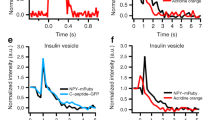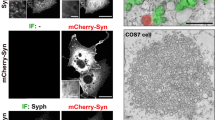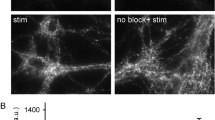Abstract
WE have suggested that microvesicles (“synaptic vesicles”) within neurosecretory terminals of posterior pituitary glands are by-products of exocytosis formed by micropinocytosis-like activity serving to recapture excess membrane, of neurosecretory granules, incorporated in the cell surface. Our view arose from the discovery of exocytotic figures in electron micrographs of these terminals and the presence, in some such figures, of indications of membrane vesiculation: caveolae with microvesicles of similar size near them1,2. The suggestion harmonized not only with the theoretical requirement for membrane recapture after exocytosis but with the familiar characteristics of the “synaptic vesicle” population: localization in terminal regions where hormone is released; aggregates against the cell membrane, the so called “synaptoid” formations; and increased number after stimulation. The scheme, however, was not entirely satisfactory since classical “synaptic vesicles”3 have smooth membranes while those apparently formed by membrane vesiculation were often seen to be coated, as were the adjacent caveolae2. While this coating supported the interpretation of such figures as micropinocytosis-like activity (coating is believed to represent the mechanism inducing membrane vesiculation4,5) it required us to postulate that coated vesicles are somehow transformed into the smooth “synaptic” type2. We here present evidence for this transformation.
This is a preview of subscription content, access via your institution
Access options
Subscribe to this journal
Receive 51 print issues and online access
$199.00 per year
only $3.90 per issue
Buy this article
- Purchase on Springer Link
- Instant access to full article PDF
Prices may be subject to local taxes which are calculated during checkout
Similar content being viewed by others
References
Nagasawa, J., Douglas, W. W., and Schulz, R. A., Nature, 227, 407 (1970).
Douglas, W. W., Nagasawa, J., and Schulz, R. A., Mem. Soc. Endocrinol. (in the press).
Palay, S. L., in Ultrastructure and Cellular Chemistry of Neural Tissue (edit. by Waelsch, H.), 31 (Hoeber, New York, 1957).
Roth, T. F., and Porter, K. R., J. Cell. Biol., 20, 313 (1964).
Kanaseki, T., and Kadota, K., J. Cell. Biol., 42, 202 (1969).
Karnovsky, M. H., J. Cell. Biol., 35, 213 (1967).
Nagasawa, J., Douglas, W. W., and Schulz, R. A., Nature, 232, 341 (1971).
Author information
Authors and Affiliations
Rights and permissions
About this article
Cite this article
DOUGLAS, W., NAGASAWA, J. & SCHULZ, R. Coated Microvesicles in Neurosecretory Terminals of Posterior Pituitary Glands shed their Coats to become Smooth “Synaptic” Vesicles. Nature 232, 340–341 (1971). https://doi.org/10.1038/232340a0
Received:
Revised:
Issue Date:
DOI: https://doi.org/10.1038/232340a0
This article is cited by
-
Membrane routing during exocytosis and endocytosis in neuroendocrine neurones and endocrine cells: use of colloidal gold particles and immunocytochemical discrimination of membrane compartments
Cell and Tissue Research (1991)
-
Vasopressin release from the isolated neurohypophysis induced by a calcium ionophore, X-537A
Nature (1974)
-
Cytophysiologie de l'excr�tion dans la posthypophyse du rat. �tude ultrastructurale apr�s stimulation in vivo
Journal of Neural Transmission (1974)
-
Cholinesterase in the posterior and intermediate lobes of the pituitary
Zeitschrift f�r Zellforschung und Mikroskopische Anatomie (1973)
-
On the origin of small adrenergic storage vesicles: Evidence for local formation in nerve endings after chronic reserpine treatment
Experientia (1973)
Comments
By submitting a comment you agree to abide by our Terms and Community Guidelines. If you find something abusive or that does not comply with our terms or guidelines please flag it as inappropriate.



